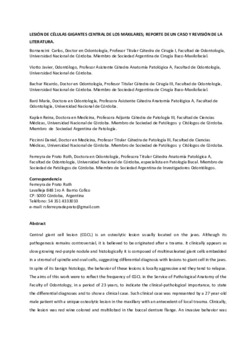| dc.contributor.author | Bornancini C,; Viotto J; Bachur R; Baró M; Kaplan R; Piccinni D; Ferreyra de Prato R | |
| dc.date.accessioned | 2019-10-29T16:05:38Z | |
| dc.date.available | 2019-10-29T16:05:38Z | |
| dc.date.issued | 2013 | |
| dc.identifier.issn | | |
| dc.identifier.uri | | |
| dc.identifier.uri | http://hdl.handle.net/11086/13446 | |
| dc.description.abstract | Abstract Central giant cell lesion (CGCL) is an osteolytic lesion usually located on the jaws. Although its pathogenesis remains controversial, it is believed to be originated after a trauma. It clinically appears as slow growing red-purple nodule and histologically it is composed of multinucleated giant cells embedded in a stromal of spindle and oval cells, suggesting differential diagnosis with lesions to giant cell in the jaws. In spite of its benign histology, the behavior of these lesions is locally aggressive and they tend to relapse. The aims of this work were to reflect the frequency of CGCL in the Service of Pathological Anatomy of the Faculty of Odontology, in a period of 23 years, to indicate the clinical-pathological importance, to state the differential diagnoses and to show a clinical case. Such clinical case was represented by a 27 year-old male patient with a unique osteolytic lesion in the maxillary with an antecedent of local trauma. Clinically, the lesion was red wine colored and multilobed in the buccal denture flange. An invasive behavior was observed in the diagnostic imaging. The histopathological study showed multinucleated giant cell component, fibrocellular stroma vascular with hemorrhagic areas and hemosiderin pigment, which led to the diagnosis of CGCL after differential analysis and clinical pathology of giant cell lesions of the jaws. In this case, the age, location and pathological study of the lesion were consistent with the literature. We aim at indicating the importance of the correct diagnosis of CGCL which requires rising differential diagnosis for all lesions in this location have giant cells, taking into account both clinical and morphology. In our case the age, location and pathological study of the lesion were consistent with the literature. It is our objective to indicate the importance of the correct diagnosis, which requires rising the differential diagnosis for all lesions in this location have giant cells for the application of a suitable treatment. | es |
| dc.description.uri | www.actaodontologica.com/ediciones/2013/4/art19.asp | |
| dc.format.medium | Impreso | |
| dc.language.iso | spa | es |
| dc.publisher | | |
| dc.rights | Attribution-NonCommercial-ShareAlike 4.0 International | * |
| dc.rights.uri | https://creativecommons.org/licenses/by-nc-sa/4.0/ | * |
| dc.subject | GIANT CELL ; OSTEOLYTIC LESION ; CHRONIC TRAUMA ; BONE ; JAWS | es |
| dc.title | LESIÓN DE CÉLULAS GIGANTES CENTRAL DE LOS MAXILARES; REPORTE DE UN CASO Y REVISIÓN DE LA LITERATURA. | es |
| dc.type | article | es |
| dc.description.version | publishedVersion | |
| dc.journal.city | Caracas | |
| dc.journal.country | Venezuela | |
| dc.journal.editorial | ÓRGANO OFICIAL DE LA FACULTAD DE ODONTOLOGÍA-UNIVERSIDAD CENTRAL DE VENEZUELA | |
| dc.journal.pagination | 21-25 | |
| dc.journal.referato | Con referato | |
| dc.journal.title | ISSN: 0001-6365 - ACTA ODONTOLóGICA VENEZOLANA | |
| dc.journal.tome | | |
| dc.journal.volume | 51 | |
| dc.description.field | Otras Ciencias Médicas | |
| dc.identifier.eissn | | |





